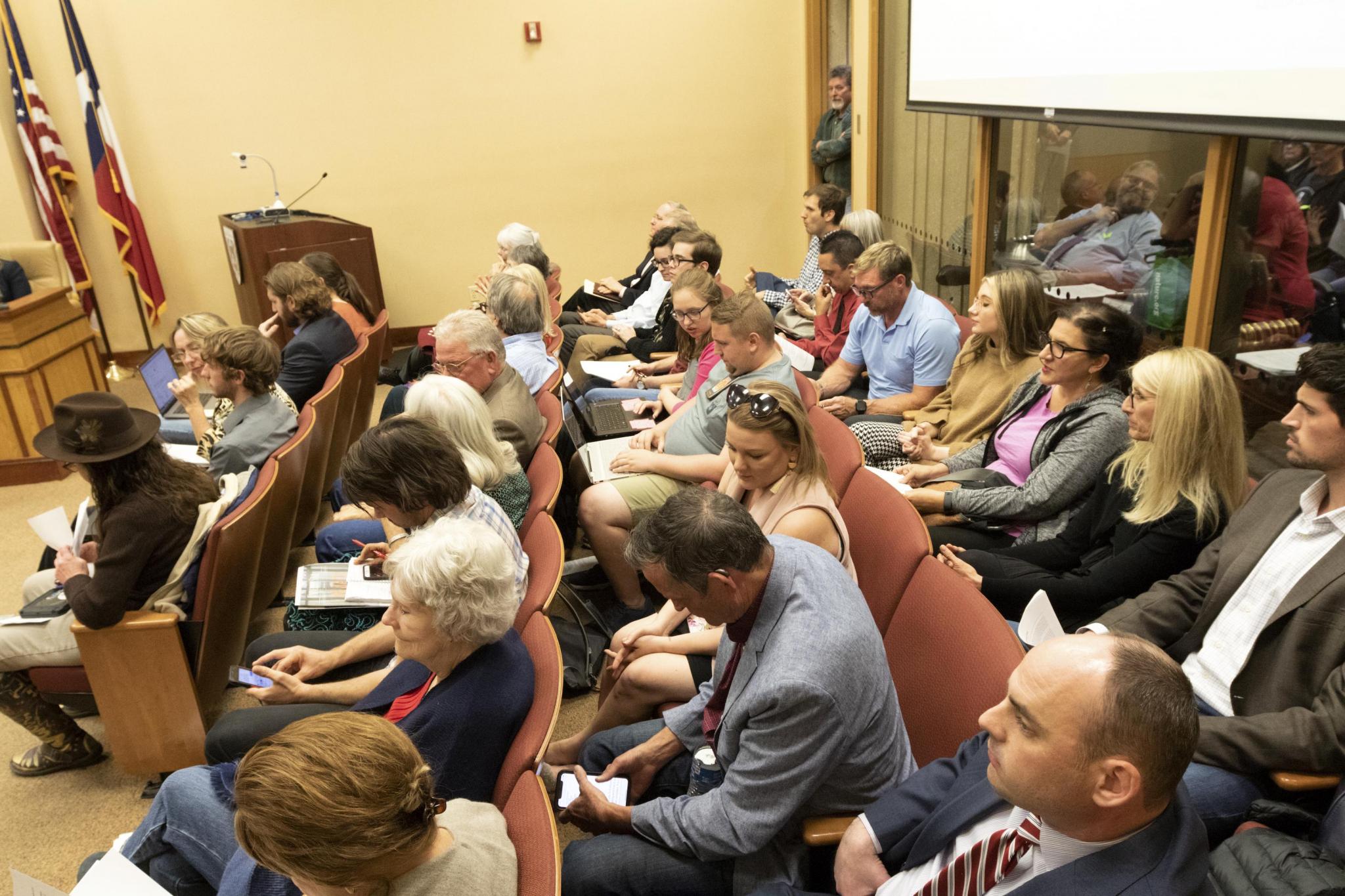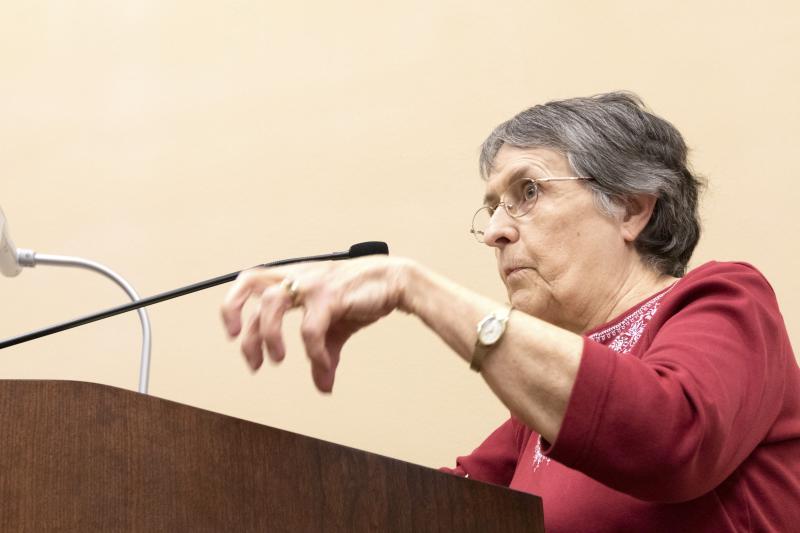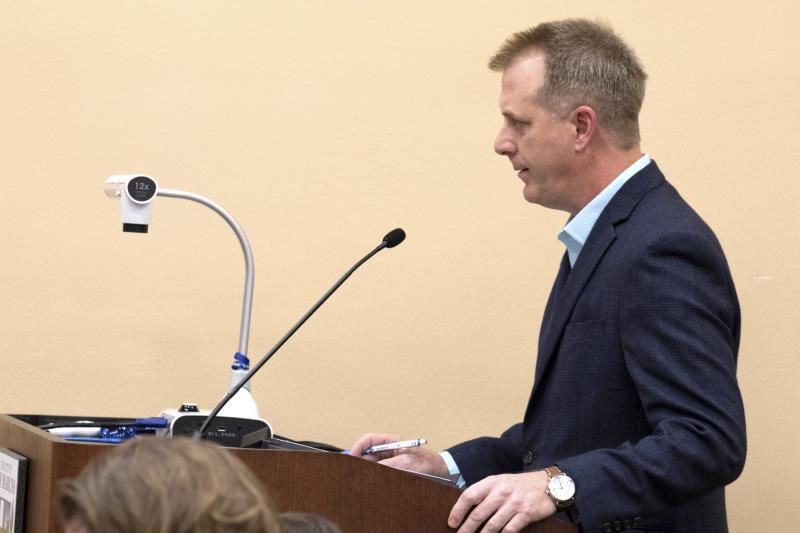
Just minutes before the start of the San Marcos City Council meeting Tuesday, the main chamber – in addition to the lobby – was full to overflowing with people wanting to comment on and watch the Council’s vote on the annexation and rezoning of land for the SMART Terminal industrial rail park. Daily Record photos by Denise Cathey
SMART Terminal a ‘go’
San Marcos is expanding by 734 acres and gaining an industrial rail park.
At its meeting Tuesday, the San Marcos City Council voted 6-1 to approve a Chapter 380 economic development agreement with the SMART Terminal industrial rail park, to annex 734 acres for the project and to rezone the annexed property to Heavy Industrial. The lone dissenter on all three votes was Joca Marquez.
Public comments
Council allowed 20 speakers during public comments (the usual limit is 10), and 19 of the area residents who spoke voiced either support for or concerns about the SMART (San Marcos Air, Rail and Truck) Terminal.
Joe Ptak asked council to postpone its votes on the terminal “for at least six months” to get answers to questions and allay residents’ concerns instead of moving forward with a project being billed as a “once-in-a-lifetime” opportunity that must be approved now. He noted that a similar project — a hotel and conference center the developer wanted to build on the hill above Spring Lake — was also promoted as a “once-in-a-lifetime, state-of-the-art” development that needed immediate approval.
“That hotel and conference center now sits at McCarty Lane and I-35,” he said.
Other area residents voiced concerns about issues ranging from an extraterritorial jurisdiction (ETJ) dispute between San Marcos and Martindale to the size of the project to financing for the development to the timing of the council’s vote. Some speakers said the meeting had been rescheduled at Katerra’s request and was held during spring break when many students and families are out of town. Mayor Jane Hughson later pointed out that the council meets on the first and third Tuesday of each month, so the March 19 meeting was a regular one. However, emails from city staff dated March 1 said the agenda items regarding the SMART Terminal, initially scheduled for council’s March 5 meeting, had been delayed at Katerra’s request.

Mary Beth Harper, who lives near the site, spoke in opposition to the project.
Representatives from Smarter San Marcos presented council with 12 pages of maps and questions about the development. Jordan Buckley compared testing the new land development code with a large industrial project to serving a new recipe to a crowd of 900 before making a test batch first. Frank Parrott asked about financing, debt and what the timeline is for 100 percent completion.
“If it’s 25 years from now, it’s a bad deal for San Marcos,” he said, noting that the last industrial park developed in San Marcos was River Ridge, which he said is still 50 percent vacant though it was platted in 1986.
Former Mayor John Thomaides spoke in favor of the development, sharing a letter signed by six former San Marcos mayors in support of the SMART Terminal.
“Just think what those jobs mean to the real citizens of our city,” he said, noting that a good-paying job with benefits could give families the chance to buy homes, put children through college and save money for retirement.
“The time is now to give our citizens that need these jobs the most the chance for a better life,” he said.
San Marcos CISD Superintendent Michael Cardona also expressed support for the development and the opportunities it would present for a partnership with the school district and for jobs for SMCISD graduates.
Dianne Wassenich, speaking on behalf of the San Marcos River Foundation, said that the foundation had decided not to oppose the development after reading the economic development agreement and the constraints included in it.
“We’re afraid that people are not understanding that things have really changed since the Woods Apartments got built,” she said. “... It’s a different council and different flood regulations.”
She offered for the foundation to host a meeting to explain the watershed plan and flood regulations to the public.

John Thomaides, former mayor, spoke in favor of the SMART Terminal.
Planning and Zoning Commissioner Mark Gleason also spoke in favor of the project, noting its potential effects on the tax rolls for San Marcos and other benefits.
“There is no perfect location to build something that’s going to be 1,000 acres,” he said. “Is it a good location? I think so.”
Caldwell County Judge Hoppy Hayden voiced support for the project, noting that the Caldwell County Commissioners Court has been working with the developers “for the past several months.”
The jobs that Katerra — the SMART Terminal’s first customer — will provide will pay about $46,000 per year and have employer-sponsored health benefits, Hayden said, adding that the jobs could “better the lives of a large number of Caldwell County residents.”
‘A different level of control’
Assistant City Manager Steve Parker made a presentation before the vote on the Chapter 380 agreement outlining the agreement and the benefits of approving the agreement and annexation of the 734-acre parcel.
“Staff’s contention through all this … is that we feel this could be developed in the county’s ETJ without San Marcos’ approval,” Parker said. “... By bringing it in for annexation and zoning we know we’re able to negotiate the standards before you tonight.”
Annexing the development and approving the economic development agreement with the developer, Michael Schroeder, would give the city “a different level of control over land use, water quality standards,” Parker said.
Regarding the ETJ issue, Parker noted that initially, the city was looking at annexing the whole 934-acre parcel, but area resident Mary Beth Harper pointed out that some of it could lie within Martindale’s ETJ.
“Our property rights related to that area were brought into play when we annexed the San Marcos Municipal Airport in 1980,” Parker said, adding that the city’s ETJ expanded to 1 mile beyond the airport with that annexation.
Martindale did not incorporate until 1982, and would not have been able to take land in the existing San Marcos ETJ into its ETJ.
“We’ve never had any discussions one way or the other whether that San Marcos ETJ is in dispute for the 734 acres we have tonight,” Parker said. “We are extremely confident that it is in our ETJ and we have every right to annex if the council so chooses.”
As for the map from the Caldwell County Appraisal District showing that the entire parcel is in Martindale’s ETJ — including the 734 acres up for annexation Tuesday night — Parker said the city has contacted the appraisal district about the map.
City engineering chief Laurie Moyer spoke to concerns about flooding and the water table beneath the property. Moyer said that Code SMTX does not allow an increase in runoff and that the developer has agreed to actually reduce runoff by 10 percent. Moyer also said that as buildings go up, it is “highly unlikely” that they will hit the water table, which is 15-18 feet below the surface at that location.
Parker went over other conditions in the development agreement, including reductions in impervious cover, sound levels and emissions; the placement of “more commercial type business” like a hotel, office building or restaurant on the edge of the development closest to the river; a list of prohibited uses for the land; and a statement that the restrictions will run with the land, not with the owner.
Council’s thoughts
Council member Lisa Prewitt noted that when the council was working on Code SMTX, people said the developers would never allow it.
“We did it,” she said. “It was unanimous. The developers didn’t even fight us.”
She said that she did not take residents’ concerns lightly but that there is a need for jobs, affordable housing and new ways of transporting both people and goods. The SMART Terminal would help fill those needs.
“The biggest piece of this, too, that I want people to keep coming back to and remembering is that there’s a willing seller to the property. He wants to sell it. There’s a willing buyer right now that we can work with,” Prewitt said, adding that another buyer might not be as willing to come to the city and be annexed and brought under the conditions the city has set.
Council member Melissa Derrick noted that most of the council members met each other while protesting developments like The Woods and a proposed development in Sessom Canyon.
“Most of us, we understand the fear of change, the fear of development, the fear of anything near the river,” she said.
However, she said she has faith in the code and in the Chapter 380 agreement.
“We didn’t leave any stone unturned,” she said. “... Basically, anything that would harm the river or the people in that neighborhood cannot be there.”
Derrick also noted, “We need the jobs. We are one of the poorest communities, poorest areas, in our region.”
Marquez asked City Attorney Michael Cosentino point blank about the ETJ issue. He reiterated Parker’s point about the airport annexation in 1980 and that since Martindale was incorporated in 1982, its ETJ “could not include any of the land already included in San Marcos’ ETJ.”
Council member Mark Rockeymoore spoke to the complexity of the issue and the “what ifs” in people’s minds.
“I wish we lived in the future,” he said, noting that he had not made up his mind even shortly before the vote.
Council member Saul Gonzales said that his mother’s house had flooded twice so he is sympathetic to people worried about flooding. However, he said, the development code is “one of the best things this council has ever done” and would prevent problems with the SMART Terminal.
“I think we also need the employment, the tax base,” he said.
Council member Ed Mihalkanin thanked residents who have spoken against the terminal for their input.
“Your concerns have made these agreements better,” he said.
He noted that the SMART Terminal would bring needed jobs and an expanded tax base that could help the city reach its goals.
“We have been struggling for years in not being able to provide jobs and economic opportunities for so many of our citizens,” he said. “And this council is committed to workforce development and workforce housing, but the means by which we can do this is to have increased tax revenue.”
“We have voted against projects that we thought were bad projects,” Hughson said. “Believe me, if I thought it was a bad project, I would not be for it.”
She noted that jobs at the industrial park would be welcomed by those who are unemployed, under-employed or “driving to another city in horrendous traffic every day.”
The mayor also said, “Opportunities for a full-time job with benefits is way better than two or three part-time jobs with no benefits,” and called the opportunities at the SMART Terminal “a game-changer for families.”
She also assured the public that the council would remain vigilant during the development.
“We will be keeping a close eye on the entire process.”











